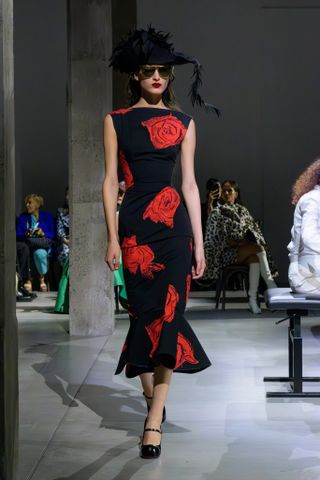A slight shift in scheduling sees Milan Fashion Week move a day earlier this season, the extension giving some much-needed breathing room to an always-packed programme. ‘I’m very satisfied with this synergetic effort by the four main players on the fashion circuit,’ said Carlo Capasa, president of Camera della Moda, the week’s organising body. ‘[We] had for some time been asking for an extension of the Milan Fashion Week, given its calendar of over 200 appointments.’
What to expect, then, from stop three on this season’s fashion week tour? Roman house Fendi will begin proceedings on the afternoon of 17 September, followed by Marni, which stays in Milan after its return last season (previously, it had been on something of a world tour, showing across the globe from New York to Tokyo). Elsewhere, expect no doubt blockbuster shows from Gucci, Versace, Ferragamo, Dolce & Gabbana, Versace, Bottega Veneta and Prada, the last likely taking place amid a continuation of its ‘fairytale ravescape’ set revealed at its menswear show in June.
Those not showing this season include Tom Ford – new creative director Haider Ackermann will debut next year – and Giorgio Armani, which will show in New York in October, part of the eponymous designer’s 90th birthday celebrations. Missing too are MSGM (the brand will show via a more intimate presentation in its HQ) and Blumarine, where David Koma will present his first collection next season. Rounding out the week is some fresh talent: Central Saint Martins graduate Susan Fang will present her latest collection with the support of Dolce & Gabbana on Sunday morning.
Here, reporting live from Milan, Wallpaper* fashion features editor Jack Moss picks the best of Milan Fashion Week, as it happens.
The best of Milan Fashion Week S/S 2025
Marni

(Image credit: Courtesy of Marni)
Following a world tour that included stops in New York and Tokyo, Marni’s Francesco Risso returned home to Milan last season, with the designer choosing to stay in the city for S/S 2025. In fact, this was just about as close to home as you could get: Risso selected Marni’s headquarters on Viale Umbria to stage the show, which unfolded in a vast concrete hall entirely covered with wooden bistro chairs at alternating angles. In the centre, three pianos – led by the musician Dev Hynes – started to play as the show began, seeing models emerge in threes and weave their way through the chairs on seemingly random paths (when the lights came up at the end of the show, they had, in fact, been following different coloured lines along the floor).
It set a theatrical stage for a revelatory collection from the designer, who eschewed the raw creativity of recent seasons for an exercise in glamour and polish – albeit in Risso’s offbeat style. It largely centred on plays on midcentury silhouettes: narrow-waisted dresses were adorned with floral prints, opera coats were slung gently off the shoulder, while dramatic headwear was adorned with ‘feathers’ recalling cut-out paper (a similar technique was used to create a play on the feather boa). Meanwhile, a masculine slant came in broad tailoring, leather jackets and high-waisted trousers, recalling 1960s greasers. Make-up saw arching Divine-style eyebrows on men and women, the look becoming more exaggerated as it reached the final looks: a flurry of flared, couture-like gowns, adorned with crystal flowers. It was a collection that Risso said was about a pursuit of beauty, an act he likened to ‘chasing a white rabbit across your yard’. ‘This is the romance of Marni: the ephemeral, lingering desire to go chasing rabbits,’ he said.
Fendi

(Image credit: Photography by Estrop/Getty Images)
As renovations of Fendi’s Milan headquarters on Via Solari continue, it was out to a vast soundstage on the city’s outskirts for Kim Jones’ latest ready-to-wear collection for the Roman house. Marking the beginning of a centenary year – Fendi was founded in 1925 as a leather goods manufacturer – the British designer looked for inspiration in the house’s founding decade, seeking to channel the liberated modernity of the 1920s with a feminine collection that spanned diaphanous, flapper-inspired dresses, sinuous sheer layers, and flourishes of crystal embellishment (Jones said the intricate craft on display was a bridge to his couture collections for the house, extending all the way to crystal-decorated pop socks). The languid glamour was contrasted with the near sci-fi white of the runway set, which centred on an enormous box (as a final trick, it opened to reveal a glimmering tableau of models inside).
‘The foundations of how women dress today and, in many ways, how we think are in the 1920s. It’s about modernity in style and attitude,’ explained Jones, who noted 1925 was also the year that Virginia Woolf’s Mrs Dalloway and F Scott Fitzgerald’s The Great Gatsby were published. ‘There’s a modernism in dress, design, decoration and thought. We approached the collection with these things in mind, as an amalgam of epochs, moods and techniques – then and now.’ This intermingling of eras was reflected by the soundtrack, which saw a soaring Max Richter composition interrupted by extracts of a conversation between house scions Anna Fendi and Silvia Venturini Fendi (the latter is also artistic director of accessories and menswear), in which they discuss Adele Fendi, who founded Fendi with her husband Edoardo. ‘I wanted something romantic, something with a debt to the 1920s from the 2020s,’ said Jones. It was a leap between centuries which made for perhaps his strongest Fendi collection yet.
Stay tuned for more from Milan Fashion Week S/S 2025.
